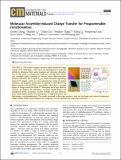| dc.contributor.author | Zhang, Zhuolei | |
| dc.contributor.author | Li, Huashan | |
| dc.contributor.author | Luo, Zhipu | |
| dc.contributor.author | Chang, Shuquan | |
| dc.contributor.author | Li, Zheng | |
| dc.contributor.author | Guan, Mengmeng | |
| dc.contributor.author | Zhou, Ziyao | |
| dc.contributor.author | Liu, Ming | |
| dc.contributor.author | Grossman, Jeffrey C | |
| dc.contributor.author | Ren, Shenqiang | |
| dc.date.accessioned | 2021-10-27T20:04:28Z | |
| dc.date.available | 2021-10-27T20:04:28Z | |
| dc.date.issued | 2017 | |
| dc.identifier.uri | https://hdl.handle.net/1721.1/134331 | |
| dc.description.abstract | © 2017 American Chemical Society. The donor-acceptor interface within molecular charge transfer (CT) solids plays a vital role in the hybridization of molecular orbitals to determine their carrier transport and electronic delocalization. In this study, we demonstrate molecular assembly-driven bilayer and crystalline solids, consisting of electron donor dibenzotetrathiafulvalene (DBTTF) and acceptor C60, in which interfacial engineering-induced CT degree control is a key parameter for tuning its optical, electronic, and magnetic performance. Compared to the DBTTF/C60 bilayer structure, the DBTTFC60 cocrystalline solids show a stronger degree of charge transfer for broad CT absorption and a large dielectric constant. In addition, the DBTTFC60 cocrystals exhibit distinct CT arrangement-driven anisotropic electron mobility and spin characteristics, which further enables the development of high-penetration and high-energy γ-ray photodetectors. The results presented in this paper provide a basis for the design and control of molecular charge transfer solids, which facilitates the integration of such materials into molecular electronics. | |
| dc.language.iso | en | |
| dc.publisher | American Chemical Society (ACS) | |
| dc.relation.isversionof | 10.1021/ACS.CHEMMATER.7B04357 | |
| dc.rights | Article is made available in accordance with the publisher's policy and may be subject to US copyright law. Please refer to the publisher's site for terms of use. | |
| dc.source | MIT web domain | |
| dc.title | Molecular Assembly-Induced Charge Transfer for Programmable Functionalities | |
| dc.type | Article | |
| dc.contributor.department | Massachusetts Institute of Technology. Department of Materials Science and Engineering | |
| dc.relation.journal | Chemistry of Materials | |
| dc.eprint.version | Author's final manuscript | |
| dc.type.uri | http://purl.org/eprint/type/JournalArticle | |
| eprint.status | http://purl.org/eprint/status/PeerReviewed | |
| dc.date.updated | 2019-09-19T13:20:28Z | |
| dspace.orderedauthors | Zhang, Z; Li, H; Luo, Z; Chang, S; Li, Z; Guan, M; Zhou, Z; Liu, M; Grossman, JC; Ren, S | |
| dspace.date.submission | 2019-09-19T13:20:31Z | |
| mit.journal.volume | 29 | |
| mit.journal.issue | 22 | |
| mit.metadata.status | Authority Work and Publication Information Needed | |
